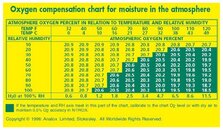The Chairman
Chairman of the Board
You're missing the point. Once you calibrated your tank, there was no 'swing'. Your technique, not the analyser was flawed. It doesn't matter if you calibrate off of air or an air tank: calibrate. If it calibrates and is stable, there is no worry about a 'swing'. However, there are many other factors, including hydration, fatigue, how close you push the tables, ascent rates, respiration rates, work rates and the list goes on, that will affect your chances of getting hurt.Then I would guess you have a much wider swing in what your analyzer reports before you question its output?
One of the best carpenters i have ever known had the most rickety table saw I've ever seen. However, he knew his equipment's limits and prduced amazing work. It's not that he eliminated the error (slop) in his saw. Rather, he designed and worked in a way that ameliorated the effect of the slop. Tables and PDSs are simply tools. You should know how and when they will fail you and dive accordingly.





